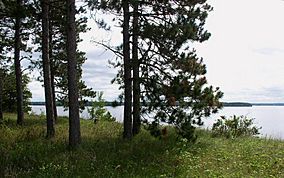Lake Wissota State Park facts for kids
Quick facts for kids Lake Wissota State Park |
|
|---|---|
|
IUCN Category V (Protected Landscape/Seascape)
|
|

Lake Wissota State Park's mix of prairie and forest is situated on the northeast shore of Lake Wissota.
|
|
| Location | Chippewa, Wisconsin, United States |
| Area | 1,062 acres (4.30 km2) |
| Established | 1961 |
| Governing body | Wisconsin Department of Natural Resources |
| Website | Lake Wissota State Park |
Lake Wissota State Park is a large state park in Wisconsin. It covers about 1,062 acres of land. You can find it near the town of Chippewa Falls. The park sits on the northeast side of Lake Wissota. This lake is actually a man-made lake, called a reservoir, created on the Chippewa River.
People love visiting the park for camping, boating, and fishing. The park's land has a mix of tall pine and hardwood trees, along with open prairie areas. Visitors can also get onto the Old Abe State Trail. This trail is great for biking or hiking. You can travel about 17.5 miles (28.2 km) all the way to Brunet Island State Park.
Contents
How the Land Was Formed
The ground under Lake Wissota State Park is very old. It has bedrock made of granite that is two billion years old! On top of that, there's a layer of 600-million-year-old Cambrian sandstone. You can actually see some of this sandstone south of the swimming beach.
Most of these old rocks are covered by a thick layer of sand and gravel left by glaciers. About 15,000 years ago, during the last ice age, a huge ice sheet called the Chippewa Lobe stopped just six miles (10 km) northeast of the park. When these glaciers melted 10,000 years ago, they left behind a lot of rock and sand. This formed a wide, flat area called an outwash plain, which is where the park is today. The melting ice also carved out the valley where the Chippewa River now flows.
A Look Back in Time
The Chippewa River Valley used to be full of white pine trees. Some people believe it had one-sixth of all the white pine trees in the United States! During the mid-to-late 1800s, people cut down most of these trees for lumber. After the trees were gone, farmers started to settle on the cleared land.
In 1917, a dam was built on the Chippewa River. This dam created Lake Wissota, which we enjoy today.
The sandy soil in the area wasn't great for farming. So, between the 1950s and early 1970s, twelve landowners joined a program called the federal Soil Bank Program. This program paid farmers to plant trees to help stop soil from washing away. About 205 acres in the park were planted with red pines. You can still see these trees along the park road near the campground.
The idea for a state park here started in 1961. State senator Davis Donnelly was a big supporter. Wisconsin spent ten years buying 990 acres of land from different owners. They also built facilities for visitors. Finally, the park officially opened to the public in 1972.
Plants and Animals
Lake Wissota State Park is in a special area where prairie grasslands meet temperate forests. The forest itself has a mix of different trees. You'll find hardwoods like sugar maple and oak trees. There are also softwoods like red and white pine.
For many years, logging and farming changed these natural areas. But now, thanks to restoration ecology efforts, the plant communities are healthy again. Park staff even use controlled burns in the prairie areas. This helps the prairie plants grow strong. The red pine forest is also carefully thinned out to keep the trees healthy. Near the swimming beach, there are special projects that show how to restore lake shorelines. These projects help teach people how to improve their own lakefront property.
Fun Things to Do
The main reason people visit Lake Wissota State Park is to enjoy the water.
Water Activities
The park has a swimming beach that is 285 feet (87 m) long. There are no lifeguards, so swim safely! This beach is very popular on warm summer weekends. There's also a two-lane boat ramp for power boats and fishing boats. You can rent canoes nearby. There's even a 25-foot (7.6 m) fishing pier that is easy for everyone to use, including those with disabilities.
Lake Wissota is home to many kinds of fish. You can catch walleye, muskies, bass, panfish, northern pike, catfish, and sturgeon. The park has even placed "fish cribs" in the lake. These are like underwater homes for fish, helping crappies and smallmouth bass find places to live. In winter, people enjoy ice fishing for crappies, walleye, and bluegill.
Camping and Trails
The family campground has 81 wooded campsites. Seventeen of these sites have electrical hookups for campers. At the south end of the park, there are two simple, tent-only group campgrounds. One can hold up to 100 people, and the other can hold up to 80 people.
The park has 17.4 miles (28.0 km) of trails for summer use. Most of these trails allow horses and mountain bikes. The Beaver Meadow Nature Trail is a shady, one-mile (1.6 km) loop. It has signs that teach you about nature. This trail goes through a wetland, a fern garden, natural springs, and an old river bed.
In winter, the park offers 9.6 miles (15.4 km) of trails for snowshoeing. There are 7 miles (11 km) for cross-country skiing and 5 miles (8.0 km) for snowmobiling.
Other Activities
The Karen Lea Nature Center is a great place to visit. It has tables with hands-on exhibits. During summer weekends, park naturalists lead special programs. The park also has two baseball fields and a volleyball court for visitors to enjoy.
|



